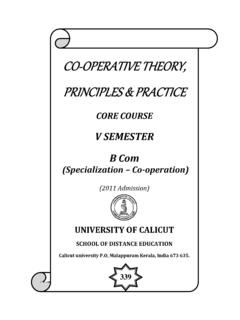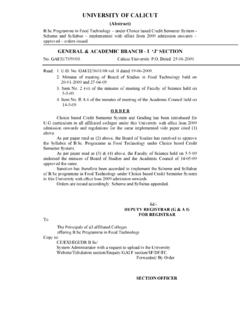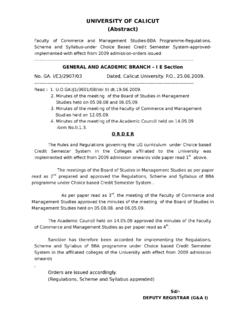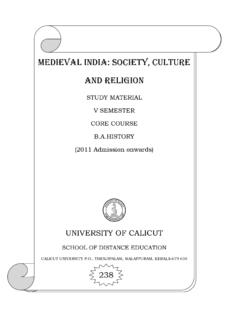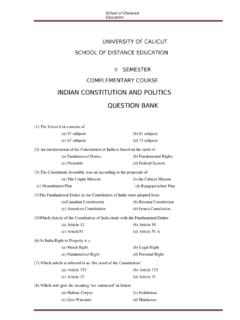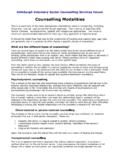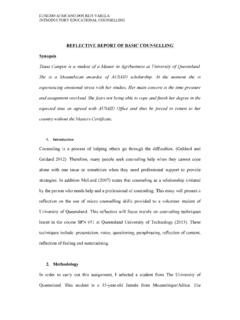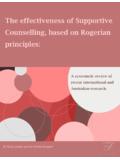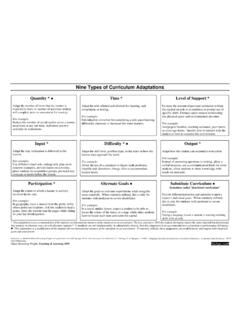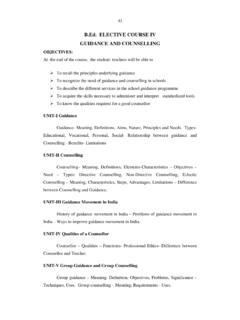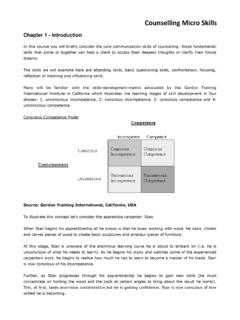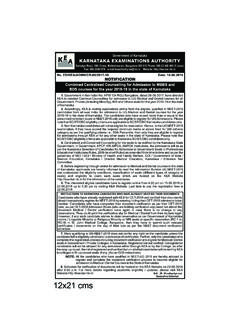Transcription of DIFFERENT APPROACHES TO COUNSELLING
1 School of Distance EducationDifferentApproachesto Counselling1 DIFFERENT APPROACHESTO COUNSELLINGVISEMESTERCORE COURSEB Sc COUNSELING PSYCHOLOGY(2011 Admission)UNIVERSITY OF CALICUTSCHOOL OF DISTANCE EDUCATIONC alicut university , Malappuram Kerala, India 673 of Distance EducationDifferentApproachesto Counselling2 UNIVERSITY OF CALICUTSCHOOL OF DISTANCE EDUCATIONSTUDY MATERIALCore CourseB Sc COUNSELLING PSYCHOLOGYVIS emesterDIFFERENT APPROACHES TO COUNSELLINGP repared&Scrutinizedby:Dr. C. Jayan,Professor,Dept. of Psychology,University of CalicutLayout:Computer Section, SDE ReservedSchool of Distance EducationDifferentApproachesto Counselling3 CONTENTSPAGE NoMODULEI4 MODULEII20 MODULEIII35 MODULEIV42 MODULEV47`School of Distance EducationDifferentApproachesto Counselling4 MODULE IPsychoanalytic TheoryPsychoanalytic theory refers to the definition and dynamics of personalitydevelopment which underlie and guide psychoanalytic and psychodynamicpsychotherapy.
2 First laid out by Sigmund Freud, psychoanalytic theory hasundergone many refinements since his work . Psychoanalytic theory came to fullprominence as a critical force in the last third of the twentieth century as part of'the flow of critical discourse after the 1960s', and in association above all withthe name of Jacques Lacan. Freud ceased his analysisof the brain and hisphysiological studies in order to turn his focus to the study of the mind and therelated psychological attributes making up the mind, something not manypsychologists were willing to do. His study then included recognizing childhoodevents that could potentially lead to the mental functioning of adults. Heexamined the genetic and then the developmental aspects that made thepsychoanalytic theory become what it basic tenets of psychoanalysis include the following: human behavior, experience and cognition are largely determined by innateand irrational drives; those drives are largely unconscious; attempts to bring those drives into awareness meet psychological resistancein the form of defense mechanisms; beside the inherited constitution of personality, one's development isdetermined by events in early childhood; conflicts between conscious view of reality and unconscious (repressed)material can result in mental disturbances such as neurosis, neurotic traits,anxiety, depression etc.
3 ; the liberation from the effects of the unconscious material is achievedthrough bringing this material into the the broad umbrella of psychoanalysis there are at least 22 theoreticalorientations regarding human mental development. The various APPROACHES intreatment called "psychoanalysis" vary as much as the theories therapy is one of the most well-known treatment modalities, but itis also one of the most misunderstood by mental health consumers. This type ofSchool of Distance EducationDifferentApproachesto Counselling5therapy is based upon the theories and work of Sigmund Freud, who founded theschool of psychology known as therapy looks at how the unconscious mind influences thoughtsand behaviors. Psychoanalysis frequently involves looking at early childhoodexperiences in order to discover how these events might have shaped theindividual and how they contribute to current actions.
4 People undergoingpsychoanalytic therapy often meet with their therapist at least oncea week andmay remain in therapy for a number of weeks, months or History of Psychoanalytic TherapyPsychoanalytic theory grew out of the work of the famous psychoanalystSigmund Freud, who began developing his therapeutic techniques in the late1800s. In 1885, Freud began to study and work with Jean-Martin Charcot at theSalp tri re in Paris. Charcot used hypnosis to treat women suffering from whatwas then known as hysteria. Symptoms of the illness included partial paralysis,hallucinations continued to research hypnotism in treatment, but his work andfriendship with colleague Josef Breuer led to the development of his most famoustherapeutic technique. Breuer described his treatment of a young woman, knownin the case history as Anna O., whose symptoms of hysteria were relieved bytalking about her traumatic experiences.
5 Freud and Breuer collaborated on abook called Studies on Hysteria and Freud continued to develop his use of this"talk therapy."Working of Psychoanalytic TherapyPsychoanalytic therapists generally spend time listening to patients talk abouttheir lives, which is why this method is often referred to as "talk therapy." Thetherapy provider will look for patterns or significant events that may play a rolein the client s current difficulties. Psychoanalysts believe that childhood eventsand unconscious feelings, thoughts and motivations play a role in mental illnessand maladaptive therapy also makes use of other techniques including freeassociation, role play and dream of Psychoanalytic TherapyWhile this type of therapy has many critics who claim that psychoanalytictherapy is too time-consuming, expensive and generally ineffective, thistreatment has several benefits as well.
6 The therapist offers an empathetic andnonjudgmental environment where the client can feel safe in revealing feelings oractions that have led to stress or tension in his or her life. Oftentimes, simplysharing these burdens with another person can have a beneficial of Distance EducationDifferentApproachesto Counselling6 Downsides to Psychoanalytic TherapyCosts are often cited as the biggest downside of psychoanalytic therapy. Manyclients are in therapy for years, so the financial and time costs associated withthis treatment modality can be very also point out that the effectiveness of psychoanalytic therapy can also bequestioned. One study found that there was no difference in therapy outcomesbetween psychoanalytic therapy clients and a placebo group. Other criticsincluding Noam Chomsky and Karl Popper suggest that psychoanalysis lacksscientific of psychoanalytic interventionsThe patient usually comes in contact with the psychoanalyst when defenses havefailed and anxiety has developed.
7 Therefore, the central focus of psychoanalytictherapy is on the unconscious part of the mind. The purpose is to uncover theunconscious motivations that regulate behavior, feeling, and attitudes and tobring about more control for the analyst employs a variety of techniques to tap into the patient s free association , the patient is encouraged to verbalize all thoughts,feelings or images that come to mind, while the analyst is seated behind thepatient. During free association, resistance may occur. This means that thepatient is unable to recall traumatic past events. Therefore, one task of theanalysis would be to overcome resistance. Another, and very important, ideaassociated with psychoanalysis, and related to the unconscious processes ofmind, is transference. Transference occurs when the patient behaves or feelstoward the analyst as he/she would have behaved or felt towards a significantfigure from his/her past.
8 Freud initially believed transference was a hurdleintherapy. However, he eventually recognized that transference is a universalphenomenon and also occurs outside of the therapy session. Throughtransference, the core neurotic characteristics of the patient are acted , the analyst attempts to clarify, interpret, confront, work throughand resolve the transference. This is the cornerstone of psychoanalysis. Othertechniques of highlighting unconscious motivations include analysis of dreamsand slippage of continued to transform psychoanalysis throughout his life. As he matured,so did psychoanalysis. His techniques have been used for an array of problems,including personal, social, occupational, and familial of Distance EducationDifferentApproachesto Counselling7 The major criticism directed towards psychoanalysis is theover-emphasis onsexual drives and motivations of children.
9 Furthermore, Freud reasoned thatpersonality is more or less developed by the age of six, and he put little emphasison significant events that may shape a person s attitudes, beliefs and sense ofself in the later stages of life. In response to these shortcomings, psychoanalysishas continued to evolve over time to include other ideas and techniques. Currentpsychoanalysts, who are also referred to as psychodynamic therapists, havebegun to consider the role of culture and have adapted traditional ideas toinclude culturally diverse clientele. Obviously, then, the classical psychoanalysisis practiced less and less by clinicians. The advent of managed care and the needto work with diverse clientele population has had a significant impact on elements among psychoanalytic APPROACHES :- Psychic determinismThe term explains that, all aspects of a person's psychological makeup arisefrom specific causes or forces, as previous experiences or instinctual drives,which may be conscious or unconscious.
10 The mental processes do not occur bychance but that a cause can always be found for them The genetic-developmental hypothesisFreudian theories point out that adult problems can be traced to unresolvedconflicts from certain phases of childhood and adolescence. Freud, based on thedata gathered from his patients early in his career, suspected that neuroticdisturbances occurred when children were sexually abused in childhood (the so-called seduction theory). Later, Freud came to believe that, although child abuseoccurs, not all neurotic symptoms were associated with realized that neurotic people often had unconscious conflicts that involvedincestuous fantasies deriving fromdifferent stages of development. He found thestage from about three to six years of age (preschool years, today called the "firstgenital stage") to be filled with fantasies of having romantic relationships withboth parents.
